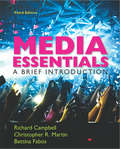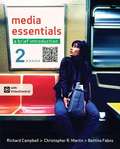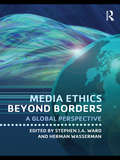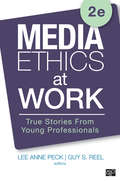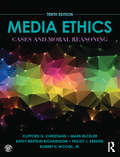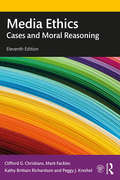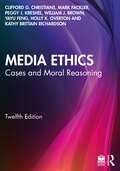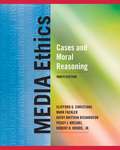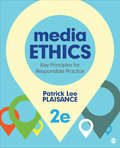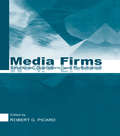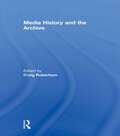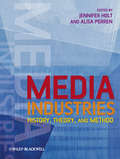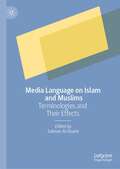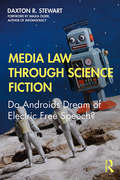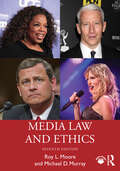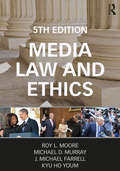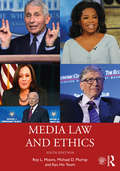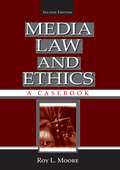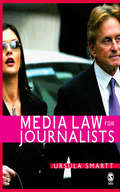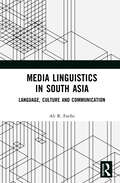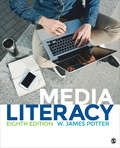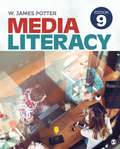- Table View
- List View
Media Essentials
by Richard Campbell Bettina Fabos Christopher R. Martin Shawn HarmsenMedia Essentials focuses on the most pivotal aspects of mass communication, and its new edition is more effective than ever at helping students understand the everchanging mass-media landscape. It features new Media Convergence and Media Literacy boxes plus specific, detailed case studies; a newly integrated chapter on the history of journalism; and an expanded program of video clips on LaunchPad that drive home the book's approach to media literacy and analysis.
Media Essentials: A Brief Introduction (Second Edition)
by Richard Campbell Christopher Martin Bettina FabosMedia Essentials focuses on the fundamentals of mass communication, helping students keep pace with today's rapidly evolving and converging media. Best-selling authors Richard Campbell, Christopher R. Martin, and Bettina Fabos distill the essential information on media industries and major concepts, incorporate their accessible critical approach, and give students all the study tools they need to succeed in the course and be savvy media consumers. For the second edition of Media Essentials, the authors have added and enriched coverage of media topics instructors asked for, including videogames, convergence, media literacy, streaming music, online journalism, and more. This all comes together in a brief, attractive format -- for a very attractive price, about 50% less than competing texts.
Media Ethics Beyond Borders: A Global Perspective
by Stephen J.A. WardThis volume explores the construction of an ethics for news media that is global in reach and impact. Essays by international media ethicists provide leading theoretical perspectives on major issues and applies the ideas to specific countries, contexts and problems, addressing such questions as: Are there universal values in journalism? How would a global media ethics do justice to the cultural, political, and economic differences around the world? Can a global ethic based on universal principles allow for diversity of media systems and cultural values? What should be the principles and norms of practice of global media ethics? The result is a rich source of ethical thought and analysis on questions raised by contemporary global media.
Media Ethics at Work: True Stories from Young Professionals
by Dr Lee Anne Peck Dr Guy S. ReelA fresh approach to building integrity in all media Media Ethics at Work: True Stories from Young Professionals (By Lee Anne Peck and Guy S. Reel) transforms students into confident, self-reliant, and ethical decision makers, prepared to resolve moral dilemmas from day one of their first media job or internship. The highly anticipated Second Edition of this text continues to engage students with true stories of young professionals working in today’s multimedia news and strategic communications organizations, helping readers create meaningful connections to real-world applications. Each story is presented as a narrative, so students can work through the ethical dilemmas as they unfold, encouraging readers to think about and ask the question: “What would I do if this happened to me?” By creating a more personalized experience for students beginning their first entry-level media jobs or internship, this book helps readers develop their own ethical standards and apply in the workplace what they have learned.
Media Ethics at Work: True Stories from Young Professionals
by Dr Lee Anne Peck Dr Guy S. ReelA fresh approach to building integrity in all media Media Ethics at Work: True Stories from Young Professionals (By Lee Anne Peck and Guy S. Reel) transforms students into confident, self-reliant, and ethical decision makers, prepared to resolve moral dilemmas from day one of their first media job or internship. The highly anticipated Second Edition of this text continues to engage students with true stories of young professionals working in today’s multimedia news and strategic communications organizations, helping readers create meaningful connections to real-world applications. Each story is presented as a narrative, so students can work through the ethical dilemmas as they unfold, encouraging readers to think about and ask the question: “What would I do if this happened to me?” By creating a more personalized experience for students beginning their first entry-level media jobs or internship, this book helps readers develop their own ethical standards and apply in the workplace what they have learned.
Media Ethics: Cases and Moral Reasoning
by Mark Fackler Clifford G. Christians Kathy Brittain Richardson Peggy Kreshel Robert H. WoodsMedia Ethics: Cases and Moral Reasoning challenges readers to think analytically about ethical situations in mass communication through original case studies and commentaries about real-life media experiences. This text provides a comprehensive introduction to the theoretical principles of ethical philosophies, facilitating ethical awareness. It introduces the Potter Box, with its four dimensions of moral analysis, to provide a framework for exploring the steps in moral reasoning and analyzing the cases. Focusing on a wide spectrum of ethical issues faced by media practitioners, the cases in this Tenth Edition include the most recent issues in journalism, broadcasting, advertising, public relations, and entertainment. Visit the companion website at http://www.mediaethicsbook.com/.
Media Ethics: Cases and Moral Reasoning
by Mark Fackler Clifford G. Christians Kathy Brittain Richardson Peggy KreshelMedia Ethics: Cases and Moral Reasoning challenges readers to think analytically about ethical situations in mass communication through original case studies and commentaries about real-life media experiences. This text provides a comprehensive introduction to the theoretical principles of ethical philosophies, facilitating ethical awareness. It introduces the Potter Box, with its four dimensions of moral analysis, to provide a framework for exploring the steps in moral reasoning and analyzing the cases. Focusing on a wide spectrum of ethical issues faced by media practitioners, the cases in this Eleventh Edition include the most recent issues in journalism, broadcasting, advertising, public relations and entertainment. Cases touch on issues and places worldwide, from Al Jazeera to the Xinhua News Agency, from Nigerian "brown envelopes" to PR professional standards in South Africa. Racially divisive language comes up in different communication contexts, as does celebrity influence on culture. A core textbook for classes in media ethics, communication ethics, and ethics in journalism, public relations, and advertising. The companion website [url] contains sample syllabi and lesson plans, PowerPoint presentations, discussion and test questions, and a library of video and other media materials for class use.
Media Ethics: Cases and Moral Reasoning
by Mark Fackler William J. Brown Clifford G. Christians Kathy Brittain Richardson Peggy J. Kreshel Yayu Feng Holly K. OvertonThrough original case studies and analyses of real-life media experiences, Media Ethics challenges readers to think analytically and critically about ethical situations in mediated communication.This textbook provides a comprehensive introduction to the theoretical principles of ethical philosophies, facilitating awareness and critical reflection of ethical issues. In each chapter, the authors examine case studies spanning several continents and geopolitical and cultural contexts. To provide a framework for analyzing the cases and exploring the steps in moral reasoning, the book introduces the Potter Box, a powerful tool for moral analysis. Focusing on a wide range of ethical issues faced by media practitioners and news organizations, the cases in this new twelfth edition include the most prominent concerns in journalism, broadcasting, advertising, public relations, and entertainment today. It explores new topics such as the use of ChatGPT in newsrooms, the privacy implications of biometric technologies, the role of public relations in political campaigns, and advertisers’ approach to sustainability and climate change.This core textbook is ideal for classes in media and communication ethics, journalism, public relations, advertising, entertainment media, and popular culture.Online instructor and student resources, including video introductions to each chapter, PowerPoint slides, sample discussion and exam questions, and links to further resources, are available at www.routledgelearning.com/mediaethics.
Media Ethics: Cases and Moral Reasoning, CourseSmart eTextbook
by Mark Fackler Clifford G. Christians Peggy Kreshel Robert H. Woods Kathy RichardsonMedia Ethics: Cases and Moral Reasoning, Ninth Edition challenges students to think analytically about ethical situations in mass communication by using original case studies and commentaries about real-life media experiences. This market-leading text facilitates and enhances students' ethical awareness by providing a comprehensive introduction to the theoretical principles of ethical philosophies. Media Ethics introduces the Potter Box (which uses four dimensions of moral analysis: definitions, values, principles and loyalties) to provide a framework for exploring the important steps in moral reasoning and analyzing the cases that follow. Focusing on a wide spectrum of ethical issues facing media practitioners, the cases in this new Ninth Edition include the most recent issues in journalism, broadcasting, advertising, public relations and entertainment.
Media Ethics: Key Principles for Responsible Practice
by Patrick L. PlaisanceMedia Ethics: Key Principles for Responsible Practice makes ethics accessible and applicable to media practice, and explains key ethical principles and their application in print and broadcast journalism, public relations, advertising, marketing, and digital media. Unlike application-oriented casebooks, this text sets forth the philosophical underpinnings of key principles and explains how each should guide responsible media behavior. Author Patrick Lee Plaisance synthesizes classical and contemporary ethics in an accessible way to help students ask the right questions and develop their critical reasoning skills, as both media consumers and media professionals of the future. The Second Edition includes new examples and case studies, expanded coverage of digital media, and two new chapters that distinguish the three major frameworks of media ethics and explore the discipline across new media platforms, including blogs, new forms of digital journalism, and social networking sites.
Media Firms: Structures, Operations, and Performance
by Robert G. PicardMedia Firms presents studies applying the company level approach to media and communication firms. It explores differences among missions, strategies, organizational choices, and other business decisions. Reviewing economic factors and pressures on media and communications companies, this book seeks to improve understanding of how these elements affect market and company structures, operations, and performance of firms. The chapters, written by leading scholars worldwide, were selected from papers on the theme of media firms presented at the 5th World Media Economics Conference hosted by the Turku School of Economics and Business Administration and The Journal of Media Economics. The collected studies provide: *an overview of economic and related managerial issues affecting the structures of markets in which firms compete; *the operations of media and communications firms; and *their financial performance. As a result, it expands the discussion of economic issues traditionally associated with the field due to narrowed focus of initial books in media economics. It is hoped that this book will induce additional avenues of inquiry regarding such issues.
Media History and the Archive
by Craig RobertsonBy the time readers encounter academic history in the form of books and articles, all that tends to be left of an author’s direct experience with archives is pages of endnotes. Whether intentionally or not, archives have until recently been largely thought of as discrete collections of documents, perhaps not neutral but rarely considered to be historical actors.This book brings together top media scholars to rethink the role of the archive and historical record from the perspective of writing media history. Exploring the concept of the archive forces a reconsideration of what counts as historical evidence. In this analysis the archive becomes a concept that allows the authors to think about the acts of classifying, collecting, storing, and interpreting the sources used in historical research. The essays included in this volume, from Susan Douglas, Lisa Gitelman, John Nerone, Jeremy Packer, Paddy Scannell, Lynn Spigel, and Jonathan Sterne, focus on both the theoretical and practical ways in which the archive has affected how media is thought about as an object for historical analysis.This book was published as a special issue of The Communication Review.
Media Industries: History, Theory, and Method
by Alisa Perren Jennifer HoltMedia Industries: History, Theory and Method is among the first texts to explore the evolving field of media industry studies and offer an innovative blueprint for future study and analysis. capitalizes on the current social and cultural environment of unprecedented technical change, convergence, and globalization across a range of textual, institutional and theoretical perspectives brings together newly commissioned essays by leading scholars in film, media, communications and cultural studies includes case studies of film, television and digital media to vividly illustrate the dynamic transformations taking place across national, regional and international contexts
Media Language on Islam and Muslims: Terminologies and Their Effects
by Salman Al-AzamiThis book brings together contributions from ten academics and a commentary from a Muslim community leader on how the British media represent some of the most important terminologies related to Islam and Muslims. It takes a nuanced approach to language within Muslims in the media research by focusing on terminologies. Each contributor in this volume focused on one terminology and its associated words to show how the representation of these terminologies have major implications on the lives of British Muslims. The book also includes some key recommendations on the usage of these terms from the Media Style Guide of the Centre for Media monitoring - a research organisation of the Muslim Council of Britain. This book’s link with the Muslim community can be a step towards new approaches in this field where academics will engage with communities and practitioners to ensure better impact of their academic works. This book will be of interest to students, scholars and practitioners in a range of fields, including Journalism, Media and Communication Studies, English Language and Linguistics, Sociology, Cultural and Religious Studies.
Media Law Through Science Fiction: Do Androids Dream of Electric Free Speech?
by Daxton R. StewartAttorney and legal scholar Daxton Stewart examines the intersection of media law and science fiction, exploring the past, present, and future of communication technology and policy debates. Science fiction offers a vast array of possibilities anticipating future communication technologies and their implications on human affairs. In this book, Stewart looks at potential legal challenges presented by plausible communication technologies that may arise 20 or 50 or 100 years from today. Performing what he calls "speculative legal research," Stewart identifies the kinds of topics we should be talking about relating to speech, privacy, surveillance, and more, and considers the debates that would be likely to arise if such technologies become a reality. Featuring interviews with prominent science fiction authors and legal scholars, and a foreword by Malka Older, this book considers the speculative solutions of science fiction and their implications in law and policy scholarship. Chapters feature specific literary examples to examine how cultural awareness and policy creation are informed by fictional technology, future societies, and legal disputes. Looking forward, beyond traditional legal research and scholarship to the possible and even very likely future of communication technology, this fascinating work of speculative legal research will give students and scholars of media law, science fiction, and technology much to discuss and debate.
Media Law and Ethics
by Roy L. Moore Michael D. MurrayThis fully revised seventh edition provides a thorough introduction to both the legal and ethical considerations relevant to students pursuing careers in media, law and communication.This comprehensive textbook integrates fundamental legal and ethical principles with cases and examples from both landmark moments and recent history. It incorporates discussion of new technologies and media throughout its coverage of core topics such as intellectual property, defamation and commercial speech. This edition introduces readers to media law in comparative international communication and explores topics such as data mining, artificial intelligence and the dark web. Coverage of recent court cases and congressional hearings bring readers up to date on the evolving discussion surrounding Facebook, X (formerly Twitter), TikTok and today’s other major online sources.This hybrid textbook is ideal for undergraduate and graduate courses in media and communication that combine law and ethics.Online resources, including sample syllabi and a test bank, are available at www.routledge.com/9781032612928.
Media Law and Ethics (Routledge Communication Series)
by Mike Farrell Roy L. Moore Michael D. Murray Kyu Ho YoumMedia Law and Ethics is a comprehensive overview and a thoughtful introduction to media law principles and cases as well as related ethical concerns relevant to the practice of professional communication. This is the fi rst textbook to explicitly integrate both media law and ethics within one volume. Since it integrates both current law and ethical queries, it is ideal for both undergraduate and graduate courses in media law and ethics. Co-author Kyu Ho Youm expands this edition’s international scope, updating and broadening his chapter on international and foreign law. The book also covers the most timely and controversial issues in modern American media. The new fi fth edition has been updated with current events and discusses the potential impact they have.
Media Law and Ethics: A Casebook
by Roy L. Moore Michael D. Murray Kyu Ho YoumThis comprehensive textbook provides a thoughtful introduction to both the legal and ethical considerations relevant to students pursuing careers in communication and media. The fully revised, sixth edition continues to integrate fundamental legal and ethical principles with cases and examples from both landmark moments and recent history. It expands upon the previous edition's exploration of international and non-U.S. law, introduces a new chapter on digital and social media, and incorporates discussion of new technologies and media throughout its coverage of core topics such as privacy, intellectual property, defamation and commercial speech. Coverage of recent court cases and congressional hearings brings readers up to date on the evolving discussion surrounding Facebook, Twitter and today’s other major online players. This hybrid textbook is ideal for undergraduate and graduate courses in media and communication that combine law and ethics. Online resources including chapter PowerPoint slides, study guides and sample teaching materials are available at www.routledge.com/cw/moore
Media Law and Ethics: A Casebook
by Roy L. MooreThis new edition of the casebook includes extensive excerpts from 25 major decisions by the Supreme Court of the United States in media law or related to media law. The cases are presented in the order in which they are discussed in the third edition of Media Law and Ethics by Roy L. Moore and Michael D. Murray, but the casebook is designed to be used as a supplemental text in any media law course. Each case includes a brief overview and has been edited to delete detailed citations and highly technical material. However, every effort has been made to preserve the Court's original language, including its recitation of the facts, its reasoning and the holding in the case. Most of the cases also include excerpts from the Court's syllabus, a summary prepared by the Court's Reporter of Decisions. A few of the cases include excerpts from concurring and/or dissenting opinions, where those opinions illustrate the complexity of the case or were influential in later decisions.
Media Law for Journalists
by Mrs Ursula Smartt'A refreshing complement to more venerable textbooks. Indeed, being both reflective and accessible, it is arguably a better first resort for aspirant hacks' Times Higher Education Supplement 'It is written in a clear and user-friendly style, avoiding the legalistic language that can be a problem with so many law textbooks. Particularly well written are the case studies that Ursula Smartt explains in each chapter' - Writing Magazine Media Law for Journalists functions as both an introduction and a reference guide to the main legal issues facing journalists. It is intended as a course textbook for students, first and foremost. However, it is also intended to help keep journalists out of jail and on the right side of the law. The book presumes no prior legal knowledge, but covers all the relevant areas including: defamation, privacy, contempt of court, freedom of expression, and intellectual property. It also looks at the difference between the English and Scottish legal systems as they pertain to the media. This book will be essential reading for all students of journalism as well a welcome guide to professional journalists.
Media Linguistics in South Asia: Language, Culture and Communication
by Ali R FatihiThe tone and texture of the language of media have changed considerably due to the rapid expansion of media in recent times and advancements in communication technologies. This book examines new ways to conduct linguistic explorations into the myriad of forms news is being presented and consumed. The volume contributes to the emerging field of media linguistics by measuring and analysing the associations between linguistics and the news discourse. It extends the conceptualization of language-media relations in sociolinguistics beyond the notions of ‘influence’ and ‘effect’ and broadens the theoretical and empirical scope of the discipline. The author discusses different perspectives of media linguistics; issues of variation in language of media; question of plurilingual resources; parallel language use in media and textuality of news genres. He further analyses the dynamics of news reportage by studying the coverage of conflicts, violence and dissent in South Asian media in recent decades along with the reportage of cricket headlines and news. Comprehensive and topical this volume will be useful for scholars and researchers of linguistics, media linguistics, applied linguistics, media studies, media sociology, sociology, cultural studies and South Asian studies.
Media Literacy
by Dr W. James PotterIn this media-saturated world, we must learn how to navigate through the overwhelming flood of information so we can avoid the risks and maximize its potential to help us. Media Literacy, Eighth Edition shows readers how. Drawing from thousands of media literature studies, bestselling author W. James Potter explores the key components to understanding the fascinating world of mass media. In this updated, revised, and reorganized new edition, Potter presents numerous examples and facts for readers to understand how the media operate, how they attract attention, and how they influence us on a day-to-day basis.
Media Literacy
by Dr W. James PotterIn this media-saturated world, we must learn how to navigate through the overwhelming flood of information so we can avoid the risks and maximize its potential to help us. Media Literacy, Eighth Edition shows readers how. Drawing from thousands of media literature studies, bestselling author W. James Potter explores the key components to understanding the fascinating world of mass media. In this updated, revised, and reorganized new edition, Potter presents numerous examples and facts for readers to understand how the media operate, how they attract attention, and how they influence us on a day-to-day basis.
Media Literacy
by Dr W. James PotterMedia Literacy teaches readers how to navigate through the overwhelming flood of information found in today’s media-saturated world. Drawing from thousands of media research studies, author W. James Potter explores the key components to understanding the fascinating world of mass media. Potter presents numerous examples and facts to help readers understand how the media operate, how they attract attention, and how they influence the public. The Ninth Edition has been thoroughly updated to evolve with the ever-changing media landscape and features a new chapter on fake news, debating what we as news consumers can do to recognize fake news in order to avoid its influence. Each chapter concludes with a set of exercises to help readers apply the chapter material to everyday life and engage in a step-by-step process to increase their own media literacy.
Media Literacy
by Dr W. James PotterMedia Literacy teaches readers how to navigate through the overwhelming flood of information found in today’s media-saturated world. Drawing from thousands of media research studies, author W. James Potter explores the key components to understanding the fascinating world of mass media. Potter presents numerous examples and facts to help readers understand how the media operate, how they attract attention, and how they influence the public. The Ninth Edition has been thoroughly updated to evolve with the ever-changing media landscape and features a new chapter on fake news, debating what we as news consumers can do to recognize fake news in order to avoid its influence. Each chapter concludes with a set of exercises to help readers apply the chapter material to everyday life and engage in a step-by-step process to increase their own media literacy.
